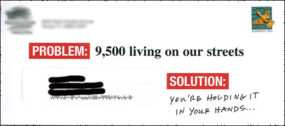Here’s an easy-to-follow tip to increase the amount of people who read your next newsletter:
Use the word “you” as the first word of the main headline on your cover.
That tells your donor right away that the newsletter is to her, and for her. And don’t you think she’ll be more likely to read if you signal to her that the newsletter is about her in some way? Versus what most organizations do, which is talk about themselves?
Want another tip? Use the word “you” again – in either the subhead or the first sentence of the main story.
Now you’re signaling to the donor that this really is about her. That the “you” in the headline was not just “donor-centered window dressing,” but was a signal that your organization really does care about her.
And now your donor is thinking, “Hey, this organization might be different from the other organizations I give to. They might appreciate me.”
And one final tip: use the word “you” in every single picture caption.
My rule is that picture captions should not be about what’s happening in the photo. Picture captions should be about the donor’s role in what’s happening in the photo. So instead of “Lisa and Laure enjoyed a week of summer camp at our facility” it should be, “Thanks to you, Lisa and Laura enjoyed an incredible week of summer camp!”
Now you’ve really done it. Your donor knows that you sent her a newsletter that’s about her and about what her gift accomplished.
That’s a Big Deal! Because very few (if any) of the other nonprofits she’s giving to have taken the time and money to show her what her gift did.
Some of them have sent her chest-thumping newsletters about what the organization did. But none of them have gotten in touch with her to tell her what she did.
Big difference.
And when you use the word “you,” she’s more likely to read more. And to know more about your organization. And to give more the next time you send her an appeal.
All from using the word “you” more often.
Think about it this way. As a donor, which type of newsletter would you like to receive: a newsletter that’s to everybody and all about the organization, or a newsletter that’s to you and all about what your gift did?
You know which one your donors would prefer. So follow these tips and make them one!
Steven Screen is Co-Founder of The Better Fundraising Company and lead author of its blog. With over 30 years' fundraising experience, he gets energized by helping organizations understand how they can raise more money. He’s a second-generation fundraiser, a past winner of the Direct Mail Package of the Year, and data-driven.









Interesting approach. I’ll have to give it a try on our next few fundraising and marketing efforts.